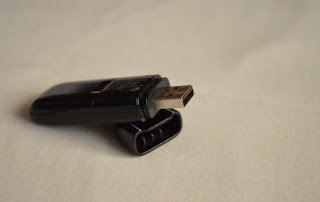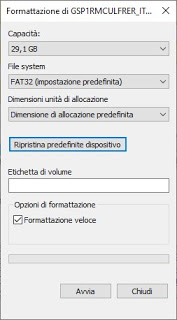
In this complete guide we will show you how to format a USB stick on Windows 10 and what are the differences between NTFS, FAT32 and exFAT, that is the most common file systems to host files on USB sticks and external hard drives.READ ALSO: How to format a disk in Windows
Guide to formatting a USB stick
In the following chapters we will show you why a USB stick is formatted, all the tools to format on Windows and Mac and which file system to use based on the size of the stick or on the system to which it will be connected.
Scenarios in which it is advisable to format the USB stick
A USB stick or hard disk or memory card for mobile phones and cameras must be formatted when:
- we note a slowness in accessing files;
- we note that some files or folders are damaged, blocked or inaccessible;
- we want to copy files over 4 GB inside but the file system does not allow it;
- we need to use the USB stick also on Mac and Linux;
- we want to quickly delete all the content inside it;
- we want to prepare the stick for the installation of Windows (Live USB).
Those exposed are the most frequent scenarios in which the formatting of the key is required. Obviously nobody forbids us to format it more often!
Quick or full format?
One of the most frequently asked questions when formatting a USB stick concerns the choice between quick and full format.
The two types of formatting are very different, although they allow you to achieve the same visible result:
- Quick formatting allows you to delete only the table of files and folders stored on the stick, without physically deleting the files; it lasts a few seconds and still allows you to view the stick as empty in the operating system (old files will be slowly overwritten every time we add new files or folders).
- Complete formatting it allows you to physically delete every file stored in the stick, therefore it requires a longer execution time (based on the capacity and the files already present).
In home scenarios it is more than enough to use quick format, so you can use the USB stick immediately. The complete formatting can be used only when we want to give the key to another person or we do not want to make old files recoverable, perhaps adding one of the cancellation methods seen in our guide Delete files securely and permanently and delete them from disk forever.
Which file system to choose?
Currently we can use four different file systems as a structure for our USB stick or external disk: NTFS, FAT, FAT32 and exFAT. Below we have collected the strengths and weaknesses of each file system, so that we can grasp the differences that exist between them.
FAT and FAT32
These are the oldest file systems to use but many sticks start with FAT32 (the only one we will consider) since it offers some more advantages in terms of performance.
- We cannot keep a file larger than 4 GB
- Compatible with all operating systems, MAC and Linux included
- They perform fewer disk writing operations and use memory faster extending the life of USB sticks
The size of the single file is its great limit, since now we are increasingly moving large files and FAT32 will certainly prevent the movement if the file is larger than 4 GB.
NTFS
This file system is also used by Windows for its system partitions and offers:
- Ability to read and write files larger than 4 GB
- Create partitions larger than 32 GB
- Compress files and save disk space.
- Better space management and less fragmentation.
- Add permissions and protections on individual files and folders.
- On Mac you can only read NTFS drives but not write on them.
- Only Xbox One reads NTFS USB sticks, which don’t work on Xbox 360 and PlayStation.
- More writing and reading, so slower and less lasting USB stick.
This file system is ideal for external hard drives and SSDs, but on a USB stick it often slows down the performance to the point of returning users immediately to FAT32, even at the expense of the limits of this old format.
ExFAT
This is a new format created to make FAT32 overcome its limits on space and file size; below we have collected its advantages.
- Maximum single file size increased to 16 Exabytes (16 billion Gigabytes)
- We can save over 1000 files per folder
- Good compatibility with all modern operating systems
- No drop in disk or stick performance
exFAT actually combines the essential advantages of FAT (speed) and NTFS (supported large files).
To learn more, we can also read our article Format USB in exFat or FAT32 to use the stick on Mac and PC.
What is the allocation unit?
Among the options of formatting a USB stick on Windows (which we will see shortly) I also find a mysterious voice called allocation unit size.
Very briefly, let’s say that, hard drives or memory units are organized in clusters, that is, groups of which you can choose the size. If a cluster is filled, even partially, that space will be seen occupied even if, theoretically, there would still be space.
Hence, a large cluster can lead to more wasted or loose space.
With smaller clusters, on the other hand, the disk becomes slower as each file is split into smaller parts and it takes much longer to put it back together.
The optimal allocation unit size depends on what you want to do with the USB stick or pen. If you intend to store large files on this drive, it is better to format with large clusters so the drive will be faster. If the USB stick is used for small files, using small clusters brings more usable space.
Generally, the larger the USB stick, the more convenient it is to set up large allocation units. For example, for a 500 MB USB stick, select 512 bytes (FAT32) or 32 kilobytes (FAT). On a 1 TB external hard drive, select 64 kilobytes (NTFS).
How to format a USB stick on Windows
After seeing some important information about formatting the sticks together, let’s see together what we need to do for format a USB stick or external hard drive in Windows.
First we connect the disk or stick to a free USB port on our computer, then wait for Windows 10 to recognize the new drive then double click on the icon This PC from the desktop (alternatively let’s go to Start -> File Explorer -> This PC), press the right button on the USB stick or hard disk icon and click on the item Format.
We will have a simple screen where we can set all the items as learned so far. Like Capacity we leave the maximum possible value, we choose the File System adequate and the size of the allocation unit; make sure to tick the item Quick format, choose a volume label (a name to easily recognize the stick or disk) then press the button Starts to start quick format (it will take a few seconds).
If we don’t know what options to set, we can use the button Restore device defaults and immediately press on Starts, letting Windows do it all.
If we have problems with this procedure we advise you to read the steps described in our guide on how Initialize and format new or unrecognized disk (Windows).
Conclusions
Formatting a USB stick on Windows is an apparently trivial operation: as seen in the guide, we will have to make targeted choices also based on what we have to do with the stick and the size of the files we want to keep. In another article, we can deepen the guide for format SSD or computer hard drive.
In other articles we talk about how recover deleted files from a USB stick or memory card.

